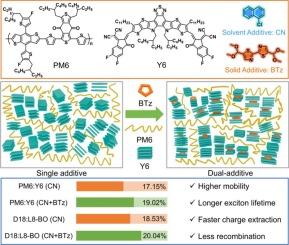Bithiazole derivative as a solid additive endows organic solar cells with enhanced photovoltaic performance
IF 13.2
1区 工程技术
Q1 ENGINEERING, CHEMICAL
引用次数: 0
Abstract
The dual-additive strategy, which combines solid additives and solvent additives, holds great promise yet remains challenging for synergistically optimizing the molecular orientation and crystalline behaviors of photoactive materials. Herein, a newly designed solid additive, 5,5′-bis(dimethoxymethyl)-2,2′-bithiazole (BTz) was synthesized. Characterized by a rigid planar structure and uneven electron distribution, BTz has robust molecular interaction with non-fullerene acceptors, which effectively optimized the crystallinity and molecular stacking of Y6. By combining the traditional solvent additive 1-chloronaphthalene (CN), the dual-additive approach facilitated more ordered self-assembly of the acceptors in the blend films with bi-continuous interpenetrating networks. The morphology optimization of the active layer promoted more efficient charge dynamics and synergistically enhanced the key photovoltaic parameters of the devices, including open-circuit voltage, short-circuit current and fill factor. Compared to the benchmark devices processed with CN alone, the additional incorporation of BTz boosted the power conversion efficiencies of PM6:Y6-, PM6:L8-BO- and D18:L8-BO-based systems to 19.02 %, 19.58 % and 20.04 %, respectively, which implies the effectiveness and universality of the dual-additive strategy in optimizing the performance of non-fullerene organic solar cells.

双噻唑衍生物作为固体添加剂赋予有机太阳能电池增强的光伏性能
结合固体添加剂和溶剂添加剂的双添加剂策略在协同优化光活性材料的分子取向和结晶行为方面具有很大的前景,但仍然具有挑战性。本文合成了一种新型固体添加剂,5,5′-双(二甲氧基甲基)-2,2′-双噻唑(BTz)。BTz具有刚性的平面结构和不均匀的电子分布,与非富勒烯受体具有强大的分子相互作用,有效地优化了Y6的结晶度和分子堆叠。通过与传统溶剂添加剂1-氯萘(CN)的结合,双添加剂方法使受体在具有双连续互穿网络的共混膜中更有序地自组装。有源层的形貌优化促进了更有效的电荷动力学,并协同提高了器件的关键光伏参数,包括开路电压、短路电流和填充因子。与仅用CN处理的基准器件相比,BTz的额外加入使PM6:Y6-、PM6:L8-BO-和D18:L8-BO系统的功率转换效率分别提高到19.02 %、19.58 %和20.04 %,这表明双添加剂策略在优化非富勒烯有机太阳能电池性能方面的有效性和普遍性。
本文章由计算机程序翻译,如有差异,请以英文原文为准。
求助全文
约1分钟内获得全文
求助全文
来源期刊

Chemical Engineering Journal
工程技术-工程:化工
CiteScore
21.70
自引率
9.30%
发文量
6781
审稿时长
2.4 months
期刊介绍:
The Chemical Engineering Journal is an international research journal that invites contributions of original and novel fundamental research. It aims to provide an international platform for presenting original fundamental research, interpretative reviews, and discussions on new developments in chemical engineering. The journal welcomes papers that describe novel theory and its practical application, as well as those that demonstrate the transfer of techniques from other disciplines. It also welcomes reports on carefully conducted experimental work that is soundly interpreted. The main focus of the journal is on original and rigorous research results that have broad significance. The Catalysis section within the Chemical Engineering Journal focuses specifically on Experimental and Theoretical studies in the fields of heterogeneous catalysis, molecular catalysis, and biocatalysis. These studies have industrial impact on various sectors such as chemicals, energy, materials, foods, healthcare, and environmental protection.
 求助内容:
求助内容: 应助结果提醒方式:
应助结果提醒方式:


